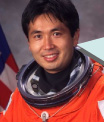|
|||||
| << September | November >> |
This is JAXA's Japanese astronaut primary activity report for October 2005.
 |
 |
| Astronaut Wakata (right) and Astronaut Wolf (left) during the test | Astronaut Wakata (left) and Astronaut Wolf (right) at the press conference |
Astronaut Wakata and Astronaut David Wolf of NASA participated in the Kibo EVA procedure development test No. 6 (OPS #6), conducted in the Weightless Environment Test (WET) Building of the Tsukuba Space Center. Through the use of space suits for underwater operations and the buoyancy of water to simulate a zero-gravity environment, the astronauts sought to establish more efficient assembly procedures by confirming the existing assembly procedure, translation of the astronauts during their EVA, and times required for the various operations.
During the test, both astronauts followed the actual on-orbit assembly procedures for the Pressurized Module (PM) and the Exposed Facility (EF) in the Japanese Experiment Module, “Kibo”.
The procedures verified the cooperative tasks and the times required for their completion.
Also, a mockup of a battery was mounted on the Exposure Pallet, which is part of the H-II Transfer Vehicle (HTV).
A simulated anomaly confirmed that the battery could be removed during the EVA.
 |
We checked the assembly procedures of Kibo and the design of the HTV for tasks undertaken during an EVA by actually wearing the space suits and by working in the pool.
|
 |
| Astronaut Doi participating from TKSC |
This simulation focused on the roles of the flight directors and flight controllers who will take part in the operation of the Japanese Experiment Module Kibo. During this training, Kibo's operations control system at the Tsukuba Space Center (TKSC), the ISS/Kibo simulator at NASA's Johnson Space Center (JSC), and the ISS operations control system at JSC were all linked together and exchanged data transmissions.
Three Japanese Astronauts participated in this simulation. Astronaut Doi, the capsule communicator (CAPCOM) from TKSC, transferred information smoothly and accurately between the crew and the ground centers. Astronaut Yamazaki, from JSC, participated as part of the on-orbit crew, and Astronaut Hoshide, also from JSC, attended the CAPCOM operation.
 |
 |
| Astronaut Yamazaki (right) in the ISS/Kibo simulator | Astronaut Hoshide watching CAPCOM operation |
During the simulation, the astronauts focused on activation operations for the Experiment Logistics Module Pressurized Section (ELM-PS). All of the ELM-PS equipment was activated, and a public affairs office (PAO) event was held at the ELM-PS according to the timeline, as if this were an actual operation. Anomalies were also planned for the scenario. By simulating the discussions held on the anomalies and by replanning the operations schedule, the simulation's goals were accomplished.
The flight director and flight controller preparations for the Kibo operations are progressing satisfactorily. There will be more operations simulations linking JAXA and NASA as well as the one conducted within JAXA.
In October, Astronauts Furukawa, Hoshide, and Yamazaki continued their Space Shuttle Mission Specialist training, which included space shuttle system training, ISS training, and T-38 flight training.
In addition to lectures on Space Shuttle Systems, the continuing training for the month included the use of simulators for responding to anomalies (malfunction training), as well as a final evaluation exam for each of the space shuttle’s subsystems. The astronaut candidates (ASCANs) split up into teams as part of the operations training and performed the necessary tasks. Based on their accumulated knowledge, they operated each subsystem, communicated with crew members and mission control center, responded to anomalies, divided the operational tasks among the crew members, and determined the priorities of tasks, all in a very short timeframe. The current emphasis of the ongoing training requires more operational capabilities than ever before.
In addition to skill-training lectures, astronauts attended lectures on each subsystem, at an operator’s level. These systems included the Thermal Control System, Environmental Control and Life Support System, Attitude Control System, Photo/TV System, Robotics/Mechanics System, and Inventory Management System. In addition, final assessment exam for each of the subsystems were conducted.
| << September | November >> |

|